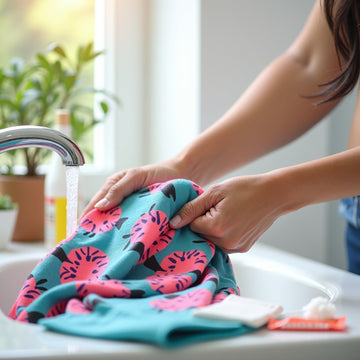Discover essential rash guard care tips to wash, dry, and maintain your gear like new. Keep your favorite rash guards fresh, odor-free, and long-lasting with simple steps anyone can follow.
Why Proper Rash Guard Care Matters
We all know the feeling: you pull on your rash guard, ready for the surf or gym, and notice that musty odor or faded print. Here’s the thing—neglecting care shortens its lifespan, leads to skin irritation, and even affects performance. Whether you’re paddling out or rolling on the mat, having a well-maintained rash guard ensures comfort, UV protection, and confidence.
Maintenance isn’t rocket science, but it pays to learn a few techniques. Think of your rash guard like a car—regular servicing prevents breakdowns. A flimsy rinse doesn’t cut it; you need targeted steps to wash, rinse, and store properly. Keep reading for pros’ tips and real-world practice, and check out our rash guard maintenance guide for more.
Understanding Rash Guard Materials
Not all rash guards are created equal. Most are made from blends of polyester, nylon, and spandex or elastane. Each fabric brings something to the table:
- Polyester: Durable, colorfast, resists UV damage.
- Nylon: Soft, stretchy, but may fade faster.
- Spandex/Elastane: Provides stretch and snug fit.
Knowing your gear’s composition guides your cleaning routine. A lightweight, breathable blend dries faster, while denser materials need extra airflow. Before washing, always check the care symbols on tags—this helps you choose the right cycle and temperature.
Washing Your Rash Guard: Step-by-Step
Cleaning your rash guard correctly makes all the difference. Follow these steps:
- Rinse Immediately: Use cold water to flush out chlorine, salt, and sweat.
- Choose the Right Detergent: Look for a mild, sports-specific formula. Avoid bleach and fabric softeners.
- Hand Wash or Gentle Cycle: If machine washing, place the rash guard in a mesh bag on low spin.
- Use Lukewarm Water: Hot water can break down elastane and cause shrinkage.
- Rinse Thoroughly: Ensure no soap residue remains—leftover detergent leads to stiffness and fading.
Pro tip: Add a tablespoon of baking soda with your detergent to help tackle lingering odors. For stubborn smells, learn how to sanitize rash guard at home.
Drying Techniques to Avoid Damage
It might be tempting to toss your rash guard into the dryer, but heat is a rash guard’s worst enemy. Instead, follow these drying techniques:
| Drying Method | Pros | Cons |
|---|---|---|
| Air Dry on a Hanger | Maintains shape, no heat damage | Takes longer, may stretch if hung incorrectly |
| Flat Dry on a Towel | Prevents stretching, dries evenly | Requires surface space, longer wait |
| Low-Heat Tumble | Faster, convenient | Risk of heat damage, slight shrinkage |
| Wrapped in a Dry Towel | Speeds up moisture wicking | Only removes excess water, not full drying |
If you’re pressed for time, towel-wrapping the rash guard before air drying can halve your wait. Lay it flat on a clean towel, roll like a sushi roll—press gently, then unroll and hang or lay flat. Never squeeze or wring; that distorts the fabric’s fibers.
Storage and Maintenance Between Uses
Between surf sessions or training, proper storage prevents mildew and creases. Moisture-laden gear becomes a breeding ground for bacteria. Always fully dry before packing away.
- Fold Neatly: Avoid sharp creases by folding along natural seams.
- Use Breathable Bags: Mesh or cotton sacks allow airflow and block dust.
- Rotate Your Gear: Don’t wear the same rash guard two days in a row—rest days let fabrics recover and release any trapped moisture.
- Inspect Regularly: Look for loose threads or small tears that can become big rips.
These simple rituals keep your kit ready for action. Dive deeper into storage tricks for peak performance.
Common Rash Guard Problems and Fixes
No matter how careful you are, issues arise. Here’s how to tackle the most frequent headaches:
| Problem | Fix |
|---|---|
| Fading Colors | Use UV-blocking detergent and wash inside out in cold water. |
| Stubborn Odor | Soak in a vinegar-water solution (1:4) for 30 minutes, then rinse. |
| Loose Seams | Reinforce with a zigzag stitch or use tear-proof tape, then wash gently. |
| Pilling | Gently remove pills with a fabric shaver, then wash on delicate. |
Small fixes now avoid costly replacements later.
Eco-Friendly Cleaning Tips
Want to be green in your rash guard maintenance? Beyond saving gear, you’re protecting oceans and waterways from harsh chemicals. Here are eco-friendly cleaning strategies:
- Choose Biodegradable Detergents: Brands like Tide Free & Gentle or eco-certified sports detergents work wonders.
- Vinegar Rinse: A natural softener and deodorizer—just add half a cup to the rinse cycle.
- Cold Wash Only: Saves energy and preserves elastic fibers.
- Spot Clean When Possible: A quick dab with mild soap prevents full washes and conserves water.
Implementing these practices keeps your gear pristine while shrinking your environmental footprint. Sustainable habits don’t have to be complicated—or boring.
When to Replace Your Rash Guard
Even with stellar care, nothing lasts forever. Watch for these signs that it’s time to upgrade:
- Significant Fading: Colors no longer vibrant, print peeling.
- Permanent Stains or Odors: Persists after multiple washes and vinegar soaks.
- Loss of Elasticity: Garment sagging, no snug fit around wrists or waist.
- Structural Damage: Rips beyond simple seam repairs, frayed panels.
If you’re ticking off these boxes, treat yourself to a fresh design for better performance and longer life.
Summary and Soft CTA
Maintaining your rash guard isn’t just about looking good—it’s about preserving function and investment. From immediate rinses to eco-friendly detergents, each step helps extend its lifespan. Remember: wash cold, dry gently, store dry, and tackle issues promptly. Stick to these guidelines, and you’ll save money, reduce waste, and enjoy peak performance every session.
Ready to refresh your lineup? Explore our latest collection and give your training kit the attention it deserves. Stay protected, sustainable, and stylish out there!
Updated: 08-18-2025










